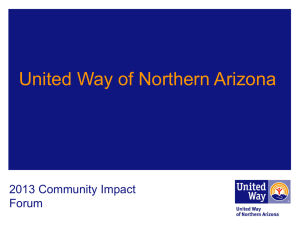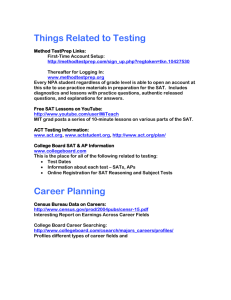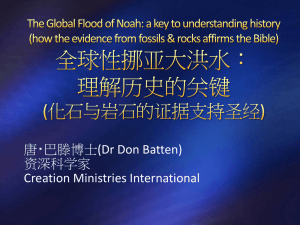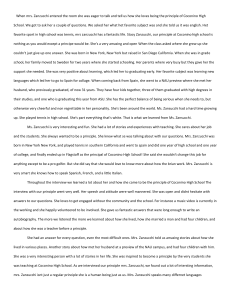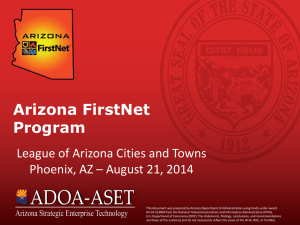The Trust for Public Land
advertisement
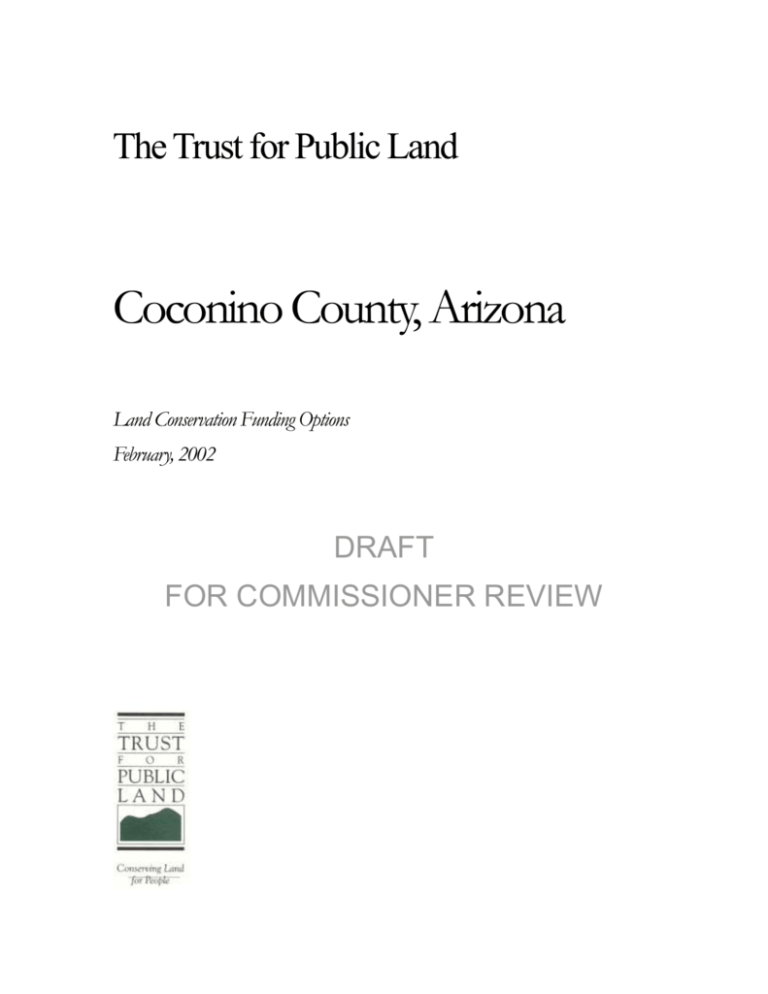
The Trust for Public Land Coconino County, Arizona Land Conservation Funding Options February, 2002 DRAFT FOR COMMISSIONER REVIEW Introduction The Trust for Public Land (TPL) is a national nonprofit land conservation organization working to protect land for human enjoyment and well-being. TPL helps conserve land for parks, greenways, recreation areas, watersheds and wilderness. To date, TPL has helped protect some 1,500 properties, totaling more than one million acres in 45 states. To help public agencies or land trusts acquire land, TPL also assists local communities in identifying and securing public financing. TPL’s conservation finance program offers technical assistance to elected officials, public agencies and community groups to design, pass and implement public funding measures that reflect popular priorities. In Arizona, TPL has helped protect over 186,000 acres since 1980. Two years ago, TPL helped the City of Prescott with three conservation acquisitions to protect both the prominent ridge of Thumb Butt and an important preserve area in Granite Dells. These acquisitions follow TPL’s conservation financing assistance to the City in which TPL polled Prescott voters and directed a campaign that led to the passage in May 2000 of a 1% sales tax extension. Last year, TPL also worked with Coconino National Forest to acquire the 90-acre Bradshaw Ranch and protect it from possible subdivision; this is the fifth property in the Sedona area that TPL has conveyed to the National Forest under a program started in 1998 with the support of the Arizona congressional delegation. 1 Coconino County: Overview General Description1 Coconino County, established in 1891, is located in central region of northern Arizona. Comprising 18,608 square miles, Coconino is the largest county in the state, and the second largest county in the United States, but it is one of the most sparsely populated. It is characterized by rugged mountains, deep canyons, and thick forests. Its many scenic sites, including Grand Canyon National Park, the Navajo National Monument, and the San Francisco Peaks, make the county a year-round mecca for tourists and outdoor enthusiasts. There are six incorporated cities in the county: Flagstaff (the county seat), Fredonia, Leupp, Page, Tuba City, and Williams. Indian reservations comprise 38 percent of the land and are home to Navajo, Hopi, Paiute, Havasupai and Hualapai tribes. The U.S. Forest Service and the Bureau of Land Management control 32 percent of the land, and the state of Arizona owns another 9.5 percent. The central corridor of Coconino County has been designated as an Enterprise Zone, as well as the central corridor of the City of Flagstaff. Population The current population of Coconino County is estimated at 116,320. Roughly 40 percent of county residents live in unincorporated areas. The largest city in the county is Flagstaff, with 36,000 residents. Nearly 30 percent of county residents are Native American. Coconino County Population 1980 Arizona 1990 % Change 2000 %Change 2,716,546 3,665,228 35% 5,130,632 40% Coconino County 75,008 96,591 29% 116,320 20% Flagstaff 36,208 38,142 5% 36,160 -5% Fredonia 1,040 1,207 16% 1,036 -14% Leupp, Navajo Nation 1,298 1,503 16% 970 -35% Page 4,907 6,598 34% 6,809 3% Tuba City, Navajo Nation 5,045 7,323 45% 8,225 12% Williams 2,266 2,532 12% 2,842 12% Source: U.S. Census Burea, April 2000. Economy The economy of Coconino County is based primarily on government, the service industry, wholesale and retail trade, and tourism. The county has the highest per capita tourism employment in the state, accounting for 31 percent of its private sector employment (the average in the U.S. is 12-19 percent). As such, the county is heavily dependent on tourism as a source of tax revenues. The median household income is $26,112, below both the state ($38,537) and national ($41,343) average. The average value of a single family home in the county is $124,994.2 1 2 Excerpted from Arizona Department of Commerce, Coconino County Profile. Excerpted from Coconino County Adopted Budget FY 2001-2002. 2 Government Overview County Government The county is governed by a five-member Board of County Supervisors. Members are elected by district to four-year terms. Coconino County Board of Supervisors Name Paul Babbit Elizabeth Archuleta Matt Ryan Deb Hill Louise Yellowman Position District 1, Chairman District 2 District 3 District 4 District 5 Term Ending Nov-04 Nov-04 Nov-04 Nov-04 Nov-04 Party Democrat Democrat Democrat Democrat Democrat Coconino County Fiscal Overview County services and programs are funded through revenue that is derived from many different sources including property tax, sales tax, fees, fines and intergovernmental agreements. While some revenues may be spent on any countywide service, many revenue sources are limited to a specific program or service. The single largest fund in the county is the General Fund, which accounts for 31 percent of the county’s budgeted revenue in FY 2002. The proposed 2002 budget for the General Fund totals $37,232,706. Public safety and judicial services account for nearly half (48.8 percent) of General Fund expenditures. Parks and recreation account for a very small portion of the General Fund budget with just $465,765 budgeted for FY 2002. Approximately $4.5 million is provided for parks and recreation in the capital projects budget. The county’s most important revenue sources are: Coconino County Top Ten Revenue Sources $16,000,000 State Shared Sales Tax – General Fund Highway User Revenues – Public Works County Sales Tax – General Fund Jail Sales Tax – Jail District County Property Tax – General Fund Prisoner Housing Revenue – Jail District Vehicle License Tax – General Fund Library District Taxes – Library District Forest Fees Federal Transit Authority Sect: 5307 $14,000,000 $12,000,000 $10,000,000 $8,000,000 $6,000,000 $4,000,000 $2,000,000 $0 y rit ho ut A it ns ra lT ra s de s xe Fe Fee Ta st ct re s tri x Fo e Ta Di e y nu ar ns ve br ce Re Tax Li Li ng rty le si ic e eh Hou rop V er ry P on a is im Pr Pr ty un Tax Co x es s Ta al e s il S le nu Ja Sa Rev x ty er Ta un Us es Co ay Sal w ed gh Hi ar Sh e at St 3 Coconino County General Revenue Fund Projections - Five-Year Plan Average Annual Dollars in Millions Growth 2001 2002 2003 2004 2005 2006 FY 02-06 Revenues 36.6 37.2 37.8 38.6 39.6 40.5 2.2% Expenditures 35.4 39.9 40.2 40.6 41.1 41.6 3.4% 2.4 4.4 5.9 7.0 Fund bal. -2.6 - Source: Coconino County Adopted Budget FY 2001-2002. Land Conservation and Parks Parks and Recreation The Coconino Parks and Recreation Department consists of three divisions: Parks, County Fair, and Racing. The Department has undertaken a strategic planning process to provide it with a clear direction to guide operations and management of parks programs, events and facilities. The process has included a series of public workshops. The preliminary needs assessment, based on the parks and recreation resource inventory results, calls for additional historic sites and wildlife preserves, as well as regional parks, particularly in more rural areas. Chief among the departments goals for recreation and services in the county are to increase services to underserved areas, to improve trail opportunities, and acquisition of additional natural areas and cultural resources. The Parks and Recreation Department has embarked on a master plan aimed at the refurbishment of the Fort Tuthill County Fairgrounds and the construction of three new parks. Within Fort Tuthill, a new amphitheater is being constructed. Other major projects include the equestrian stables and posse arena, the grandstands, fairgrounds, and campgrounds. Construction began in FY01 for Peaks View Park, a major new park in the Doney Park area, Sawmill multi-cultural art and nature park adjacent to the Rio de Flag, and the expansion of Raymond Park. Several new trials are also being constructed. These trails will complement the Flagstaff Urban Trails System.3 3 Excerpted from the Coconino County Capital Improvement Plan FY 2002-2006. 4 Revenue Options for Open Space Property Tax Overview The governing body of a county or municipality may levy a property tax for the acquisition and maintenance of public parks or it may appropriate funds for such purpose.4 Counties and cities are limited to an increase in total property tax levies of 2 percent over the previous year. Voter approval is required to exceed these limits. The override measure must state the number of years in which the tax will be effect, estimated tax costs, and the purpose for providing the revenue. Arizona’s property tax rate is based on the assessed value of the property and is levied using a combination of primary and secondary rates. Primary taxes are used to meet operating expenses of local jurisdictions. Secondary taxes are used to meet special obligations, such as the repayment of bonds and special district levies and voter-approved overrides. Total property tax liability is calculated by adding primary and secondary tax rates for all jurisdictions in which the property tax payments are located.5 Under the primary system, the full cash value of locally-assessed property may not increase by more than 10 percent per year. Primary taxes levied on residential property only are limited to 1.0 percent of the full cash value of the property. In addition, primary taxes collected on all types of property are limited to a maximum increase of 2 percent over the prior year’s levy plus new construction. The average real and personal property tax in the state is $12.70 on $100 of assessed valuation. An example of a property liability calculation follows:6 $ 100,000 x 10% $ 10,000 x .0570 $ 770 Secondary – full cash value7 Residential assessment ratio Secondary net assessed value (NAV) Secondary tax rate $5.70/$100 Secondary tax liability $ Primary net assessed value (NAV) Primary tax rate $7.00/$100 Primary tax liability $ 9,300 x .0700 651 $ 1,421 Total Taxes Owed 4 Arizona Revised Statutes: 11-937. “Taxation: City and State Requirements,” The Business book; www.abgnews.com. 6 General Tax Information, Arizona Department of Commerce; www.commerce.state.az.us. 7 Full cash value is essentially equal to market value. 5 5 The Property Tax in Coconino County Coconino County uses primary property taxes to fund a portion of its General Fund budget; secondary taxes are levied to fund libraries, fire districts, and flood control projects. The county currently does not levy its primary tax levy to the maximum allowed under the law. If the county were to raise its primary property tax levy to the maximum, based on 2001 assessed valuation, the increase would result in additional revenue of approximately $1.6 million. The adopted 2002 budget calls for a total tax rate of 0.5977 per $100 of assessed value. The primary tax rate of $0.3433 is expected to generate roughly $3.5 million for general county operations. This tax rate has remained unchanged since 1999. Two secondary taxes are levied by the county for libraries and the fire district assistance Property Tax Levy Rates 2001 fund. The total secondary tax rate is (Special districts not included.) 0.2544. Municipalities, school districts and Taxing District Rate other special districts impose additional Coconino County $ 0.5977 property taxes. The typical homeowner ($125,000 home value) pays approximately $830 a year in property taxes. Education Equalization (State & County) City of Flagstaff City of Williams 1.0951 1.7127 1.3995 Source: Coconino County Adopted Budget 2001-2002. Using the Property Tax to Fund Land Conservation A county can establish a parks operation and enhancement fund with monies budgeted by the county board of supervisors, grants, gifts and donations, parks user fees, concession fees, and revenues from county parks publication and souvenirs. This fund can be used to acquire real estate for new parks or expansion of existing parks.8 Coconino County could raise a substantial amount of money on an annual basis for open space acquisition by increasing the county secondary tax rate for that purpose. Based on a total assessed valuation in the county of $1.06 billion, an increase of 0.1 percent in the tax rate would contribute approximately $1 million annually for open space. This tax increase would cost the average household in the county an additional $13 per year. Estimated Revenue & Costs of Property Tax Increase Coconino County Tax Rate Assessed Annual Cost / $125K Increase Valuation Revenue House 0.05 $1,062,082,181 $531,041 0.10 $1,062,082,181 $1,062,082 $12.50 $6.25 0.15 $1,062,082,181 $1,593,123 $18.75 0.20 $1,062,082,181 $2,124,164 $25.00 The county Board of Supervisors may conduct an election to authorize a property tax levy that is not within the limitations on primary property taxation. The board must adopt a resolution by a vote of 8 Arizona Revised Statutes: 11-941. 6 at least 2/3rd to put the issue to a vote. The question shall be submitted to the qualified electors of the county at a special election held on the third Tuesday in May before the beginning of the fiscal year in which the taxes are to be levied. In the resolution requesting the voters to approve the levy, the board shall state: The number of years in which the authority to levy taxes in excess of the limitations otherwise prescribed is to be in effect. The board shall not request authority from the voters for a period of less than two years nor more than seven years. The purpose for providing revenue to the county. The maximum dollar amount of secondary property tax that may be collected in each year of the authority if voters approve the levy. The estimated secondary property tax rate that will be levied in the first year if the voters approve the levy. If the levy is approved by the voters, the maximum amount of taxes that the board may levy for any year in which the authority is in effect is the amount stated in the resolution requesting voter approval of the levy 7 Transaction Privilege Tax (Sales Tax) Overview Although it’s usually passed onto the consumer, the state sales tax is actually a tax on the vendor for the privilege of doing business in Arizona. Some counties and most cities impose additional taxes above the state levy. The state transaction privilege and use tax rate is 5.6 percent; the range of local rates is 0 to 4.5 percent. The state average is 7.3 percent. All sales tax revenues are directed to the general fund unless they are dedicated as transportation sales tax funds. However, counties with fewer than 2 million people may impose a capital projects tax with majority voter approval. With a unanimous vote, the board of supervisors may submit a proposal for approval at a countywide special or general election. The tax rate may not exceed 10 percent of the state transaction privilege tax rate, either by itself or together with a roads tax. The county may only use the revenues for capital projects, including the purchase of property or development rights for open space. The ballot measure shall list each project to be financed with the tax collected and the estimated costs of each project. The tax terminates if and when the total amount of estimated costs for all of the projects has been raised.9 (There is also a state bill this year to authorize a special district, funded by a ¼-cent sales tax, for open space, recreation, parks, and cultural activities. There are currently no bill sponsors.10) Using the Capital Projects Sales Tax for Land Conservation The transaction privilege tax levy in Coconino County is 0.8 percent, 0.5 percent for the general fund and 0.3 percent for the jail fund. Most Arizona counties levy between 0.5 and 1.0 percent. City rates in Coconino range from 1.51 percent in Flagstaff to 3.0 percent in Williams. The county has the capacity under state law to levy a capital projects tax of up to 0.56 percent. Based on current county sales tax collections, a capital projects tax of 0.25 percent could be expected to raise roughly $4.6 million for this purpose. The tax must be submitted to the voters by the Board of Supervisors. Approval by a majority of the voters is required. Estimated Revenue & Costs of Sales Tax Increase Coconino County Tax Rate Annual Cost Per Increase Revenue Household 1/16 $1,150,000 $9.75 1/8 $2,300,000 $19.50 1/4 $4,600,000 $39.00 9 Arizona Revised Statutes 42-6111. Phone conversation with Sally Bender, Associate Director of the Arizona County Supervisors Association, December 21, 2001. 10 8 Impact of 0.25 Percent Sales Tax Increase Coconino County Arizona Total County Personal Income (PI) - 1999 PI spent on taxable items (25%) divided by Number of households in county (est. 1999)* equals Dollars spent on taxable items per household multiplied by Sales tax levy Per household impact of sales tax $2,438,492,000 $609,623,000 39,478 $15,442 0.25% $39 Sources & assumptions Personal income and number of households for county from US Census. Personal income spent on taxable items from Bureau of Economic Analysis, Personal Consumption Expenditure by Type of Product. *1999 households estimated from 2000 census figure 40,448, and 1999 population. General Obligation Bonds Legal Background on Bonds To raise funds for capital improvements, such as land acquisition or building construction, counties may issue bonds. There are two types of bonds: general obligation (G.O.) bonds, which are guaranteed by the county’s property taxing authority, and revenue bonds that are paid by project-generated revenue. General obligation bonded indebtedness for counties or general municipal purposes may not exceed 15 percent of the secondary assessed valuation of the taxable property. The public entity is authorized to levy property taxes or to draw from other unrestricted revenue streams such as sales or income taxes to pay the bond’s principal and interest. Interest rates on these bonds are generally the lowest of any public securities due to this superior security. The process for passage of G.O. bonds is as follows:11 11 An election to approve bonded indebtedness can be called by the governing body of a local government or initiated by petition of 15 percent of the voters. A majority of voters must approve the bond question for passage. The county board or governing body must order the election to be held not less than 30 nor more than 150 days from the date of the order. Not less than 10 days and not more than 40 days before the bond election, an informational pamphlet must be mailed to each voter. This pamphlet outlines the amount of the bond, maximum interest rate, estimated debt retirement schedules, source of repayments, estimated issuance costs, estimated tax rate impact on the average assessed valuation or residential and commercial property, purpose for which the bonds are to be issued, current outstanding general obligation debt and constitutional debt limitation and election information. At the election the ballot shall contain the phrases “for the bonds” and “against the bonds”. The voter shall be indicated by inserting the mark “x: in the square opposite such phrase. No other question, word or figure need be printed on the ballot. The ballot need not be any particular size, nor need sample ballots be printed, posted or distributed. Arizona Revised Statutes 48-806. 9 Coconino County Debt Since 1998, Coconino County has issued debt (in the form of Certificates of Deposit, “COPS”12, and Pledged Revenue Obligations) to finance a new jail, make general facility infrastructure improvements, and begin a multi-year overhaul of its park facilities. These debt issues will be repaid over 15 years. In accordance with its debt policy, when the county committed to financing these capital projects it set up specific reserve accounts using accumulated General Fund cash balances to be used for debt repayment. Current balances are invested for the length of the debt maturity schedule. The debt issued for the new jail, however, will use local sales tax revenue for repayment. A 3/10 of a cent tax was approved by the voters for this purpose in July 1997.13 A maximum amount of debt outstanding has not been formally adopted by the Board of Supervisors, but it is the policy of executive management to not accumulate a principal amount outstanding that exceeds an amount of cash that can be set aside for repayment. Issuing G.O. Bonds for Land Conservation With regard to the statutory debt limits the county has ample capacity to issue bonds for land conservation (nearly $160 million). The chart illustrates the estimated annual debt service, required property tax increase and annual household cost of different general obligation bond issues. For instance, a $20 million, twenty-year, general obligation bond for parks and open space would require a levy of roughly 0.16 ($0.16 per $1,00 of taxable value) to meet the annual debt service. This would cost the owner of a $125,000 home, the average home value in the county, just over $20 per year in additional property taxes. Bond Financing Costs Coconino County 20-year Bond Issues at 6.0% Interest Rate Assessed Value = $1.06 billion Bond Issue Size Annual Tax Rate Cost/ Year/ Debt Svce Increase $125K House 10,000,000 871,846 0.08 $10.26 20,000,000 1,743,691 0.16 $20.52 30,000,000 2,615,537 0.25 $30.78 40,000,000 3,487,382 0.33 $41.04 50,000,000 4,359,228 0.41 $51.31 Other Potential Options Revenue bonds are issued to finance a specific revenue-generating project. The issuing entity pays debt service from either user fees, tolls, concessions, lease-back arrangements or revenues from the acquired or constructed facility, depending on the type of project financed. Approval by a majority of the voters voting is required. For municipalities of 75,000 people or less, recreational facilities covered by this statute include swimming pools, parks, playground, municipal gold courses, and ball parks. 12 Unlike general obligation bonds, COPs are not secured by the full faith and credit of the government issuer and do not require voter approval. COPs are secured by the particular capital project for which they are issued are are repaid by project revenues or monies appropriated annually by the local government. 13 Excerpted from the Coconino County Adopted Budget FY 2001-2002. 10 The bed tax or transient lodging tax is an additional 2 percent tax imposed on the gross income from business activity on any hotel within a city. With voter approval, counties with less than 2 million but more than 500,000 people may levy a hotel tax. This tax is in addition to any tax imposed by a city or town in the county and applies to both incorporated and unincorporated areas of the county. The tax shall be in effect for 30 years unless extended by voters. The tax rate is 1 percent of the tax base. Bed tax revenues are generally directed to the general fund. Often, cities dedicated the revenue to the local chamber of commerce for tourism promotion, as well as other projects. The government property lease excise tax is utilized when the city or town owns property that is leased by a commercial for-profit business. The tax is almost like an in-lieu or property tax and is collected by the city and then distributed among all of the entities that would be receiving property tax from the property. Revenues generated by this become general fund revenues. Excise tax incentives may be used to fund growth-related roads, parks, and other services.14 An open space checkoff has just been approved by the Tucson city council. Residents will now have the option of donating funds on their monthly water bills, replacing the checkoff for public funding of political campaigns which raises only about $6,000 a year. The Arizona Daily Star reported in November 2001 that advocates believe the voluntary conservation checkoff will raise more funds than the political checkoff, although significant revenue is not expected. Republican Mayor Walkup supported the proposal, calling it a good gauge of public support for open space preservation.15 An improvement district is a city- or county-run district of property owners who jointly pay for new projects.i The district’s purposes include the acquisition, maintenance, repair, or improvement of any real or personal property for a community center, park or recreational area.16 A district may have many other purposes and a district can’t be formed exclusively for park/recreation purposes. (According to the League of Arizona Cities and Towns, these districts have been used at the municipal level almost exclusively for road/street improvements and lighting.) Below are examples of some of the voter-approved mechanism used for funding parks and open space in other Arizona communities. Selected Examples of Local Financing Referenda for Parks and Open Space DATE OF PASS/ FISCAL JURISDICTION ELECTION FAIL TECHNIQUE Gilbert Prescott Glendale Phoenix Scottsdale Scottsdale Pima County Nov-01 May-00 Nov-99 Sep-99 Sep-99 Sep-99 May-97 69/31 51/49 68/32 80/20 77/23 69/31 68/32 General obligation bond 1-cent sales tax (portion) General obligation bond 1/10-cent sales tax General obligation bond Dedication of sales tax General obligation bond 14 AMOUNT $20.3 million $40.7 milion $53.7 million $256 million $200 million n/a $36 million Email message from Byron Smith, Arizona League of Cities and Towns, January 2, 2002. Joe Burchell, “Council Oks Open Space Checkoff,” Arizona Daily Star, November 6, 2001. 16 Arizona Revised Statutes, 48-909. 15 11 Elections Election Dates Information about specific election requirements is included with the financing option descriptions in the previous sections. Generally, voter-approved tax or bond questions may be placed on the ballot at any (or a specific) general or primary election. Voter information pamphlets are mailed to every household with a registered voter before the earliest date for receipt of a requested early mail ballot. Arguments supporting or opposing a county measure must be filed with the county elections office not less than ninety days before the elctions at which the issue is to be voted upon. The election dates for calendar year 2002 are as follows: Primary Election March 12, 2002 September 10, 2002 General Election May 21, 2002 November 5, 2002 Recent Election Results & Turnout Pending 12 13
